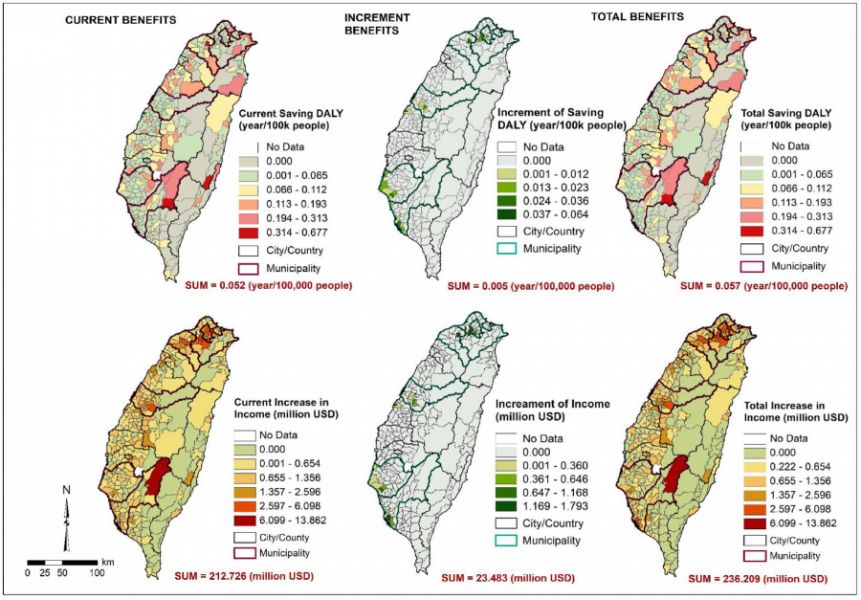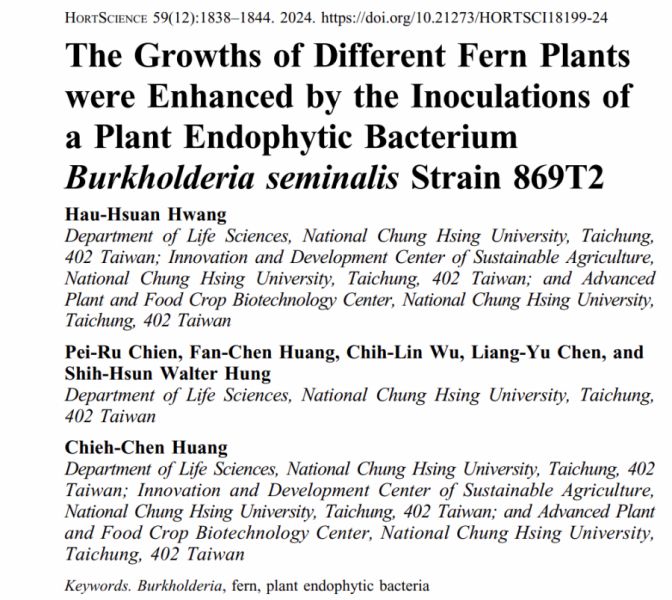生態農業:氣候變遷下森林碳匯與生態經濟評估【國立成功大學測量及空間資訊學系/吳治達教授】
| 論文篇名 | 英文:Greenspace related to bipolar disorder in Taiwan: quantitative benefits of saving DALY loss and increasing income 中文:台灣綠地空間與躁鬱症的關聯:減少DALY損失及增加收入所產生的量化效益 |
| 期刊名稱 | Health & Place |
| 發表年份,卷數,起迄頁數 | 2023, 83: 103097 |
| 作者 | Asri, Aji Kusumaning; Yeh, Chia-Hao; Chang, Hao-Ting; Lee, Hsiao-Yun; Lung, Shih-Chun Candice; Spengler, John D.; Wu, Chih-Da(吳治達)* |
| DOI | 10.1016/j.healthplace.2023.103097 |
| 中文摘要 | 越來越多的科學證據顯示,周遭的綠地對於心理健康具有正面效益。本研究旨在調查台灣地區的綠地與躁鬱症之間的關聯性,並根據國際綠地可及性標準量化綠地對躁鬱症的影響。藉由檢核348個鄉鎮的資料集,使用了兩個量化指標(DALY Loss/DALY Income)來代表不同的效益。躁鬱症的發病率來自台灣全民健康保險研究資料庫,以常態化植生差異指標(NDVI)來表示綠化程度及綠地可及性。透過廣義加乘混合模型和敏感性測試來評估統計上的關聯性。接著透過PFP參數來制定一個情境以量化效益。結果顯示,台灣的綠地與躁鬱症之間存在顯著的負相關。與綠地較少的地區相比,具有中高程度綠地的地區可能將躁鬱風險降低21%(RR= 0.79;95% CI = 0.76-0.83)和51%(RR= 0.49;95% CI = 0.45-0.53)。在計算效益時也發現到,通過提升低綠地鄉鎮中的綠地指標後,可以從目前的情況中節省由於躁鬱症導致的DALY損失高達10.97%,並增加收入高達11.04%。最後,本研究為亞太地區首次應用自定義的綠地增量情境來量化特定健康負擔(如躁鬱症)效益的研究。 |
| 英文摘要 | Scientific evidence reported that surrounding greenspace could promote better mental health. Considering bipolar disorder as the health outcome, this study aimed to investigate the association between greenspace and bipolar disorder in Taiwan and quantified the benefits of greenspace on bipolar disorder adjusted for the international greenspace availability standard. By examining datasets across 348 townships, two quantitative measures (i.e., disability-adjusted life year loss and income) were used to represent the benefits. The incidence rate of bipolar disorder was obtained from Taiwan's National Health Insurance Research Database. Normalized different vegetation index (NDVI) was measured as a proxy for the greenspace availability. A generalized additive mixed model coupled with a sensitivity test were applied to evaluate the statistical association. The prevented fraction for the population (PFP) was then applied to develop a scenario for quantifying benefit. The result showed a significant negative association between greenspace and bipolar disorder in Taiwan. Compared to low greenspace, areas with medium and high greenspace may reduce the bipolar risk by 21% (RR = 0.79; 95% CI = 0.76-0.83) and 51% (RR = 0.49; 95% CI = 0.45-0.53). Calculating benefits, we found that the development of a scenario by increasing greenspace adjusted for availability indicator in township categorized as low greenspace could save in DALY loss due to bipolar disorder up to10.97% and increase in income up to 11.04% from the current situation. Lastly, this was the first study in Asia-Pacific to apply a customized greenspace increment scenario to quantify the benefits to a particular health burden such as bipolar disorder. |
| 發表成果與本中心研究主題相關性 | 森林為農業中的重要一環,本研究成果可作為未來發展森林療育或森林保健推廣之基礎。 |







